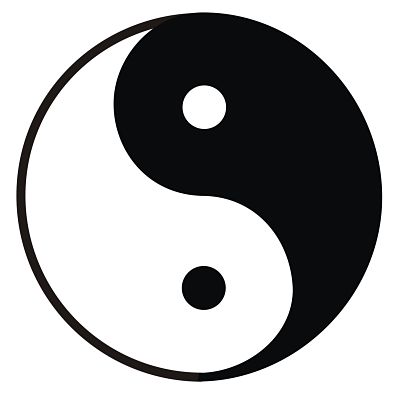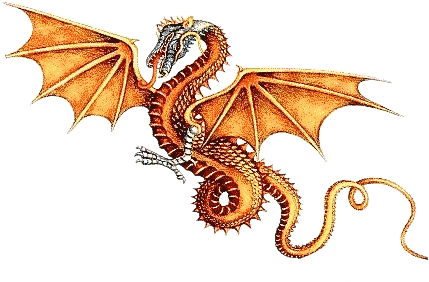Mythic thought touches the essence of experience: the significance and meaning of life. In our logos-oriented world, we must nurture our mythic side to maintain balance and health.
Our lives are filled with polar systems: good and bad, right and wrong, rich and poor, light and dark, conservative and liberal, being and nonbeing. Maintaining our mental health often rests on how well we can reconcile these poles and find a middle ground from which to live and function in our world. Many a hero’s journey begins because someone’s life has swung out of balance and is dominated by one pole, which forces him or her to disown or disavow its complimentary, balancing opposite. The tension created by this conflict triggers a journey toward reconciliation and growth.

In Eastern philosophy, the Yin-Yang symbol represents the interrelated, mutually-defining nature of poles.
Mythologies are replete with tales which illustrate polar conflicts. These myths usually involve two relatives or siblings: Gaea and Uranus (Greek), Apollo and Dionysus (Greek), Shiva and Shakti (Hindu), Cain and Abel (Judeo-Christian), Monster Slayer and Born for Water (Navajo), and Ahriman and Orhmazd (good and evil Persian twin gods). While these myths may be set in different times and different cultures, the theme they present is always the same: balance in life is necessary, and that the two poles, while apparently in opposition, are really an expression of one reality.
Polar myths are fascinating and fun, but in this post I want to turn to a more abstract expression of this theme: mythos and logos. Mythos and logos are, essentially, two ways of experiencing and understanding the world. Mythos is holistic, artistic, evaluative and intuitive. Logos is analytical, scientific, intellectual and practical. In mythos, life unfolds in a web of relationships, where ambiguity and relativity are normal. In logos, life progresses through cause and effect, where certainty and the absolute are the norms. Mythos seeks to reveal meaning; logos seeks to expand knowledge.
The need to reconcile poles
Both modes of understanding are essential in our lives.We don’t–and can’t–do away with one pole or the other because they define each other, like yin and yang, and because the tension/cooperation between them animates life. As psychologist Carl Jung wrote several decades ago, “Just as all energy proceeds from opposition, so the psyche too possesses its inner polarity, this being the indispensable prerequisite for its aliveness” (1963, p. 346). Thus, to cling to one at the expense of the other not only distorts our view of ourselves and our world, but eventually leads to stagnation and illness.
Like all polarities, mythos and logos are just two faces of one reality, and we must be able to hold and balance both to maintain our well being. Writing about religious fundamentalism, Helen Freeman made this point clearly: “Both mythos and logos were essential and inextricably linked. Meaning without practical grounding becomes abstract and unlivable. Practicalities without a core of meaning become disorientated and grindingly mundane” (2002, p. 31).

Dragons often symbolized the transcendent because they combined the body of the serpent (symbol of the earth and time) with the wings of the eagle (symbol of the sun and eternity).
Logos is science, the language of our rational brain. It expresses life rationally and objectively through observation. Logos dominates our modern culture to the point of diminishing our experience of being human. We see evidence of this in our obsession with technology, the standardization of education, the destruction of the environment in the name of progress or capitalism, and our compulsive consumption, to name just a few examples.
Mythos (myth) on the other hand, refers to the essence of our experience: the meaning and significance of life. In The cry for myth, existential psychologist Rollo May wrote that in myth, “the whole person speaks to us, not just to our brain” (May, 1991, p. 26). Myth explores elements in the human experience that are timeless and constant. More importantly, because it can contain emotion and meaning, which logos cannot, mythos—in its forms of myth, narrative, and story—is our framework for organizing experience and maintaining a sense of self. As Brian Polkinghorne explains,
…we achieve our personal identities and self concept through the use of the narrative configuration, and make our existence into a whole by understanding it as an expression of a single unfolding and developing story. We are in the middle of our stories and cannot be sure how they will end; we are constantly having to revise the plot as new events are added to our lives. Self, then, is not a static thing nor a substance, but a configuring of personal events into a historical unity which includes not only what one has been but also anticipations of what one will be. (1988, p. 150)

The Tao, the source beyond duality. It can be felt but not conceived, intuited but not categorized, divined but not explained (Chuang-tzu).
Mythos, truth and meaning
Myth, narrative, and story (mythos) are our tools for ordering experience and giving it meaning. They have this power because the narrative, poetic or mystical perspective can accommodate relationships, emotions and meaning that are destroyed by the analysis and factual description of logos. This is, in part, why Vietnam War writer Tim O’Brien wrote, “story-truth is truer sometimes than happening-truth” (1998, p. 203), and why historian and philosopher A. K. Coomaraswamy believed that “myth embodies the nearest approach to absolute truth that can be stated in words” (1943, p. 33).
Mythic thought is also the process by which we resolve psychological conflicts and keep our souls alive (May, 1991). It does this by carrying us through the process of acknowledging, understanding and resolving the contradictions in our lives. Through myth, we can step outside the perspective of our own struggling narrative and, through that expanded perspective, build a new meaning for our own story, a meaning that can contain poles not as conflicting opposites, but as two ways of understanding one whole.
As part of this mythic process, our psyches create unifying symbols, often expressed in myth, that help us reconcile the polar elements within us, guiding us toward harmony and wholeness (Feinstein & Krippner, 1997). As philosopher Alan Watts wrote (1963),
“…the language of myth and poetry is integrative, for the language of the image is organic language. Thus it expresses a point of view in which the dark side of things has its place, or rather, in which the light and the dark are transcended through being seen in terms of a dynamic unity.” (p. 15)
Restoring a balance
Today, in a world that is dominated by the manifestations of logos, we must make an effort to draw on the balancing power of mythosto ground our lives. Both are necessary to fully experience life. We must cultivate mythos in its various manifestations—myth, narrative, archetypes, symbols—to maintain our psychological health and to build the meanings that are critical to a sense of purpose and fullness in life. We must also exercise logos to provide the practical grounding that allows us to live and function in the modern technological world. Reconciling and balancing these poles is essential to continued growth and greater wisdom.
Copyright © 2013 by Reg Harris. All rights reserved. This article is excerpted and adapted from The eternal circle: A hermeneutic model of the hero’s journey (2004) by Reg Harris. Reproduction in any form, in part or in whole, without the written permission of the author is prohibited. For permission to use, please contact Reg Harris.
References
Coomaraswamy, A. K. (1943). Hinduism and Buddhism. New York: Philosophical Library.
Feinstein, D. & Krippner, S. (1997). They mythic path. New York: G. P. Putnam.
Freeman, Helen. (2002). “Facing Fundamentalism.” European Judaism. 35(1), 31.
Jung, C. G. (1963). Memories, dreams, reflections. New York: Vintage.
May, R. (1991). The cry for myth. London: W.W. Norton and Company.
O’Brien, T. (1990). The things they carried. New York: Penguin.
Polkinghorne, D. E. (1988). Narrative knowing and the human sciences. Albany, NY: State University of New York.
Watts, A. (1963). The two hands of God: Myths of polarity. New York: Collier.
